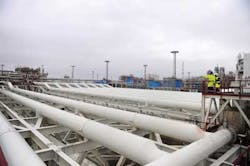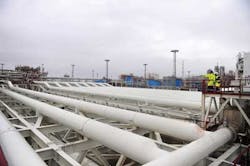GUIDE TO WORLD CRUDES: Statoil issues Snohvit condensate update
Statoil has updated an assay of the condensate stream associated with natural gas being produced from Snohvit field in the Barents Sea.
The field lies on Blocks 7120 and 7121 in the Barents Sea, west northwest of the island of Hammerfest, Norway (OGJ, Apr. 9, 2007, p. 48). It sends natural gas via a 143-km (88.8-mile) subsea pipeline to the world's only gas liquefaction plant, on Melkoye Island. (A map of the field's location appears in OGJ, June 16, 2008, p. 46.)
The gas processing plant at the Hammerfest LNG plant received gas from Snohvit in August 2007 (OGJ, Aug. 27, 2007, p. 10), but full production was delayed by leaks in the cooling system until early 2008 (OGJ, Feb. 4, 2008, p. 10).
Snohvit produces without fixed or floating units in the Barents Sea. Instead, subsea production units stand on the seabed in water 250-345 m deep. A total of 20 wells are to produce gas from the Snohvit, Askeladd, and Albatross fields, says Statoil; 9 wells are planned on Snohvit, including 8 for production and 1 for reinjecting CO2.
Six of the producers and the CO2 injection well were drilled 2004-05, with the remaining two following this year. In addition, production wells were drilled on Albatross in 2005-06; this field also forms part of the Snohvit development. Snohvit and Albatross wells came on stream in 2007; Askeladd is due to come on stream in 2014-15.
Partners in Snohvit are Statoil (operator, 33.53%), Petoro (30%), Total E&P Norge (18.40%), GDF Suez E&P Norge (12%), Hess Norge (3.26%), and RWE Dea Norge (2.81%).
Whole crude
Density at 15º C., kg/l.: 0.7339
Dry oil density15º C., kg/l.: 0.7339
API gravity at 60/60° F.: 61.3
Specific gravity at 60/60° F.: 0.7341
Sulfur, mass %: 0.020
Total acid no.: my KOH/g: <0.01
Reid vapor pressure, kPa: 48.6
Pour point, °C.: <–48
Flash point, °C.: <10
Vis. at 20° C., cst: 0.71
Vis. at 40° C., cst: 0.58
Nitrogen, mg/kg: 3
Hydrogen sulfide, mass %: ND1
Vanadium, mg/kg: <0.1
Nickel, mg/kg: <0.1
Sodium, mg/kg: <0.1
Mercury, µg/k: <1.0
Salt as NaCl, mg/l.: <5.0
Wax content, mass %: NA
Water content, mass %: <0.02
Pentanes to 65° C.
Yield on crude, mass %: 22.63
Yield on crude, vol %: 25.72
Density at 15° C., kg/l.: 0.6433
Specific gravity at 60/60° F.: 0.6433
API gravity at 60/60° F.: 88.5
Mercaptan sulfur, mg/kg: 8
n-Paraffins, mass %: 45.2
i-Paraffins, mass %: 48.5
Naphthenes, mass %: 4.5
Aromatics (incl. benzene), mass %: 1.8
n-Paraffins, vol %: 45.7
i-Paraffins, vol %: 49.1
Naphthenes, vol %: 3.8
Aromatics (incl. benzene), vol %: 1.3
Vapor pressure (DVPE1), kPa: 107.9
Research octane no. (RON): 76.3
Motor octane no. (MON): 73.8
Research octane no. (RON): 276.1
Motor octane no. (MON): 273.6
65-90° C.
Yield on crude, mass %: 15.4
Yield on crude, vol %: 15.62
Density at 15° C., kg/l.: 0.7206
Specific gravity at 60/60° F.: 0.7208
API gravity at 60/60° F.: 64.8
Sulfur, mass %: <0.001
Mercaptan sulfur, mg/kg: 7
n-Paraffins, mass %: 25.4
i-Paraffins, mass %: 27.5
Naphthenes, mass %: 35.1
Aromatics (incl. benzene), mass %: 11.9
Benzene, mass %: 11.3
n-Paraffins, vol %: 27.6
i-Paraffins, vol %: 29.5
Naphthenes, vol %: 33.1
Aromatics (incl. benzene), vol %: 9.8
Benzene, vol %: 9.2
Vapor pressure (DVPE1), kPa: 33.4
Research octane no. (RON): 68.5
Motor octane no. (MON): 66.4
Research octane no. (RON): 268.3
Motor (MON): 266.2
Nitrogen, mg/kg: <1
90-150° C.
Yield on crude, mass %: 32.82
Yield on crude, vol %: 31.73
Density at 15° C., kg/l.: 0.7561
Specific gravity at 60/60° F.: 0.7563
API gravity at 60/60° F.: 55.6
Sulfur, mass %: <0.001
Mercaptan sulfur, mg/kg: 5
n-Paraffins, mass %: 20.0
i-Paraffins, mass %: 23.4
Naphthenes, mass %: 37.3
Aromatics (incl. benzene), mass %: 19.3
Benzene, mass %: 0.5
n-Paraffins, vol %: 21.7
i-Paraffins, vol %: 24.9
Naphthenes, vol %: 36.6
Aromatics (incl. benzene), vol %: 16.8
Benzene, vol %: 0.5
Flash point, °C.: <10
Nitrogen, mg/kg: <1
150-180° C.
Yield on crude, mass %: 9.37
Yield on crude, vol %: 8.82
Density at 15° C., kg/l.: 0.7796
Specific gravity at 60/60° F.: 0.7799
API gravity at 60/60° F.: 49.9
Sulfur, mass %: 0.005
Mercaptan sulfur, mg/kg: 8
Copper corrosion: 1a
Total acid no., mg KOH/g: <0.01
| Test conditions: True boiling point distillation Equipment The distillation up to 240° C. is performed according to D-2892. Conditions* Cut points are as follows: • Atmospheric distillation: C5-180° C. AET. • 100 Torr: 180-240° C. AET. The atmospheric cut points are corrected to 760 mmHg. Volume: Volume expansion or contraction is normalized among fractions boiling at less than 150° C. in proportion to their yields. (Usually the "loss" is negative due to volume expansion.) Loss: Loss up to 240° C. AET is distributed with two-thirds in the gas-fraction and one-third in the first liquid fraction. *AET = average equivalent temperature; Torr. ≈ 1 mmHg ≈ 0.0193 lbf/sq in. |
n-Paraffins, mass %: 21.6
i-Paraffins, mass %: 29.7
Naphthenes, mass %: 27.1
Aromatics, mass %: 21.6
n-Paraffins, vol %: 23.3
i-Paraffins, vol %: 31.0
Naphthenes, vol %: 26.3
Aromatics, vol %: 19.4
Aromatics (HPLC1)
Total, mass %: 20.2
Monoaromatics, mass %: 20.2
Diaromatics, mass %: <0.1
Polycyclic aromatics, mass %: <0.1
Naphthalenes, vol %: 0.02
Aniline point, °C.: 52.3
Smoke point, mm: 26.0
Flash point, °C.: 41.5
Freezing point, °C.: <–60
Cetane index (D-976): 32.2
Calculated cetane index (D-4737): 37.1
Kin. vis. at 20° C., cst: 1.08
Kin. vis. at 50° C., cst: 0.76
Nitrogen, mg/kg: <1
Distillation D-86 (50%), °C.: 159.6
180-240° C.
Yield on crude, mass %: 10.93
Yield on crude, vol %: 10.02
Density at 15° C., kg/l.: 0.8003
Specific gravity at 60/60° F.: 0.8006
API gravity at 60/60° F.: 45.2
Sulfur, mass %: 0.017
Mercaptan sulfur, mg/kg: 5
Copper corrosion: 1a
Total acid no., mg KOH/g: <0.01
Aromatics (HPLC1)
Total, mass %: 18.0
Monoaromatics, mass %: 15.6
Diaromatics, mass %: 2.4
Polycyclic aromatics, mass %: <0.1
Naphthalenes, vol %: 1.57
Aniline point, °C.: 62.8
Smoke point, mm: 23.0
Freezing point, °C.: –50.0
Cloud point, °C.: <–51
Cold-filter plugging point, °C.: <–50
Pour point, °C.: <–48
Cetane no.: 50.3
Cetane index (D-976): 44.9
Calculated cetane index (D-4737): 46.6
Kin. vis. at 20° C., cst: 1.80
Kin. vis. at 50° C., cst: 1.15
Nitrogen, mg/kg: <1
Distillation D-86 (50%), °C.: 201.3
240°+ C.
Yield on crude, mass %: 8.03
Yield on crude, vol %: 7.04
Density at 15° C., kg/l.: 0.8372
Specific gravity at 60/60° F.: 0.8376
API gravity at 60/60° F.: 37.4
Sulfur, mass %: 0.144
Total acid no., mg KOH/g: <0.01
Aromatics (HPLC1)
Total, mass %: 21.6
Monoaromatics, mass %: 12.7
Diaromatics, mass %: 8.4
Polycyclic aromatics, mass %: 0.5
Aniline point, °C.: 76.0
Watson K-factor: 11.9
Cloud point, °C.: -5
Cold-filter plugging point, °C.: –9
Pour point, °C.: –11
Cetane no.: 58.6
Cetane index (D-976): 52.7
Calculated cetane index (D-4737): 57.8
Conradson carbon residue, mass %: <0.1
Kin. vis. at 20° C., cst: 5.52
Kin. vis. at 50° C., cst: 2.76
Nitrogen, mg/kg: 30
Basic nitrogen, mass %: 0.001
Refracxtive index at 67º C.: 1.448
Vanadium, mg/kg: <0.1
Nickel, mg/kg: <0.1
Asphaltenes, mass %: NA
n-Pentanes insolubes, mass %: <0.01
Ash, mass %: <0.001
Distillation D-86 (50%), °C.: 272.6
Composition, mass %
Normal paraffins
Methane: <0.01
Ethane: <0.01
Propane: <0.01
Butane: 1.05
Pentane: 8.57
Hexane: 5.05
Heptane: 3.56
Octane: 2.68
Nonane: 1.82
Total n-paraffins: 22.73
C4 hydrocarbons
i-Butane: 0.05
Test methods: Snohvit condensateDensity at 15° C., kg/l.: D-4052/D-5002
Dry oil density at 15° C., kg/l.: IP479
Total sulfur, mass %: D-4294
Total sulfur, mass %: D-5453 for sulfur content less than 0.01%
Hydrogen sulfide, pos./neg.: lead acetate paper
Mercaptan sulfur, mg/kg: D-3227
n-Paraffins, mass %: GC*
i-Paraffins, mass %: GC
Naphthenes, mass %: GC
Aromatics, mass %: GC
Benzene, mass %: GC
Aromatics (HPLC*), mass %: D-6591
Naphthalene, vol %: D-1840
Watson K: UOP 375
Vapor pressure (DVPE*), kPa: D-5191
Reid vapor pressure, kPa: D-323
Flash point (Pensky Martens), °C.: D-93
Freezing point, °C.: D-2386
Cloud point, °C.: D-5772
Pour point, °C.: D-5853/D-5950
Cold filter plugging point, °C.: IP 309
Kin. viscosity at 20° C., cSt: D-445
Kin. viscosity at 40° C., cSt: D-445
Kin. viscosity at 50° C., cSt: D-445
Kin. viscosity at 80° C., cSt: D-445
Kin. viscosity at 100° C., cSt: D-445
Aniline point, °C.: D-611
Research octane number (RON): D-2699
Motor octane number (MON): D-2700
Cetane index: D-976
Calculated cetane index: D-4737 Method A
Cetane number: D-613
Smoke point, mm: D-1322
Distillation of whole crude up to 375° C.: D-2892
Distillation of individual fractions: D-86
Simulated distillation: IP PM-CF/98
Total acid number (TAN), mgKOH/g: D-664
Copper corrosion: D-130
Nitrogen, <100 mg/kg: D-4629
Nitrogen, >40 mg/kg: D-5762
Basic nitrogen, mass %: UOP 269
Vanadium (V), mg/kg: ICP
Nickel (Ni), mg/kg: ICP
Sodium (Na), mg/kg: ICP
Mercury (Hg), μg/kg: FIMS* (with in-house method)
Salt as NaCl, mg/l.: IP 265
Color (ASTM): D-1500
Carbon residue (micromethod), mass %: D-4530
Asphaltenes, mass %: IP 143
n-C5 insolubles, mass %: D-4055
Ash, mass %: D-482
Penetration at 25° C., 0.1 mm: D-1321
Refractive index at 67° C.: Abbe refractometer
Wax content, mass %: UOP 46 (mod. acetone precip.)
Water content, mass %: D-4928
Compositional analysis of crude oil, mass %: D-5134
*GC = gas chromatograph; HPLC = high performance liquid chromatography; DVPE = dry vapor pressure equivalent; ICP = inductively coupled plasma; FIMS = field ionization mass spectrometry.C5 hydrocarbons
Isoparaffins
2,2-Dimethylpropane: 0.04
i-Pentane: 7.36
Total C5 i-paraffins: 7.40
Naphthenes
Cyclopentane: 0.66
C6 hydrocarbons
Isoparaffins
2,2-Dimethylbutane: 0.37
2,3-Dimethylbutane: 0.56
2-Methylpentane: 3.32
3-Methylpentane: 1.90
Total C6 i-paraffins: 6.14
Naphthenes
Methylcyclopentane (incl. 2,2-Dimethylpentane): 2.68
Cyclohexane: 2.82
Total C6 naphthenes: 5.51
Aromatics
Benzene: 2.27
C7 hydrocarbons
Isoparaffins
2,2,3-Trimethylbutane: 0.04
3,3-Dimethylpentane: 0.07
2,4-Dimethylpentane: 0.24
2-Methylhexane: 1.47
2,3-Dimethylpentane: 0.27
3-Methylhexane: 1.44
Total C7 i-paraffins: 3.52
Naphthenes
cis-1,3-Dimethylcyclopentane: 0.44
trans-1,3-Dimethylcyclopentane: 0.40
trans-1,2-Dimethylcyclopentane: 0.82
Methylcyclohexane: 4.74
Ethylcyclopentane: 0.26
1,1-Dimethylcyclopentane: 0.24
Total C7 naphthenes: 6.9
Aromatics
Toluene: 3.29
C8 hydrocarbons
Isoparaffins
2,2,4-Trimethylpentane: <0.01
2,5-Dimethylhexane: 0.17
2,4-Dimethylhexane: 0.20
3,4-Dimethylhexane: 0.03
3,3-Dimethylhexane: 0.06
2,3-Dimethylhexane (incl. naphthenic compound): 0.18
2-Methyl-3-ethylpentane: 0.04
2-Methylheptane: 1.14
4-Methylheptane: 0.35
3-Methylheptane: 3<0.01
2,3,4-Trimethylpentane: 0.02
Total C8 i-paraffins: 2.19
Naphthenes
1,1,3-Trimethylcyclopentane (incl. 2,2-Dimethylhexane): 0.27
trans, cis-1,2,4-Trimethylcyclopentane: 0.19
trans,cis-1,2,3-Trimethylcyclopentane: 0.20
trans-1,4-Dimethylcyclohexane: 0.38
1,1-Dimethylcyclohexane: 0.11
trans-1-Methyl-3-ethylcyclopentane: 0.09
cis-1-Methyl-3-ethylcyclopentane: 0.07
trans-1-Methyl-2-ethylcyclopentane: 0.17
trans-1,2-Dimethylcyclohexane: 0.36
2-Propylcyclopentane: 0.03
cis-1,2-Dimethylcyclohexane: 0.16
Ethylcyclohexane: 0.74
1-Propylcyclopentane: 0.39
cis,cis-1,2,4-Trimethylcyclopentane: <0.01
1-Methyl-1-ethylcyclopentane: 0.02
cis-1,3-Dimethylcyclohexane (incl. naphthenic compound): 31.64
Total C8 naphthenes: 4.82
Aromatics
Ethylbenzene: 0.52
m-Dimethylbenzene (m-xylene): 1.34
p-Dimethylbenzene (p-xylene): 0.51
o-Dimethylbenzene (o-Xylene): 0.54
Total C8 aromatics: 2.91
C9 hydrocarbons
Isoparaffins
3,5-Dimethylheptane: 0.33
4-Methyloctane: 0.25
2-Methyloctane: 0.40
3-Methyloctane: 0.47
2,3,4-Trimethylhexane: <0.01
Unidentified paraffin: 0.10
Total C9 i-paraffins: 1.55
Naphthenes
1,1,3-Trimethylcyclohexane: 0.27
1-Methyl-2-propylcyclopentane: 0.10
1-Methyl-3-ethylcyclohexane: 0.26
1-Methyl-4-ethylcyclohexane: 0.16
1,1,4-Trimethylcyclohexane: 0.10
Unidentified naphthenes: 0.11
Total C9 naphthenes: 1.00
Total identified: 70.93
Total unidentified: 0.14
Total C10+: 28.93
1ND = not detectable; NA = not analyzed due to nature of the sample; HPLC = high performance liquid chromatography; DVPE = dry vapor pressure equivalent. 2Corrected in accordance with EN 228. 3Not possible to distinguish between 3-Methylheptane and 1,3-Dimethylcyclohexane.
More Oil & Gas Journal Current Issue Articles
More Oil & Gas Journal Archives Issue Articles
View Oil and Gas Articles on PennEnergy.com

